Financial Accounting Report: Reporting Entity and Capital Maintenance
VerifiedAdded on 2022/11/14
|16
|4108
|67
Report
AI Summary
This report delves into key financial accounting concepts, examining the characteristics of a reporting entity as defined by the Statement of Accounting Concept 1 (SAC1) and its application to government organizations. It explores the concept of physical capital maintenance and its impact on the decision usefulness of financial information, contrasting it with financial capital maintenance. The report further analyzes the quality of AASB 137 disclosures regarding provisions, contingent liabilities, and contingent assets in the financial reports of Woolworths Group and Origin Energy, assessing their compliance with relevant accounting standards. The analysis highlights the importance of these concepts for accurate financial reporting and informed decision-making by stakeholders. The report also emphasizes the role of physical capital maintenance in providing a more accurate picture of a company's profitability and operational effectiveness.

Financial Accounting
1
1
Paraphrase This Document
Need a fresh take? Get an instant paraphrase of this document with our AI Paraphraser
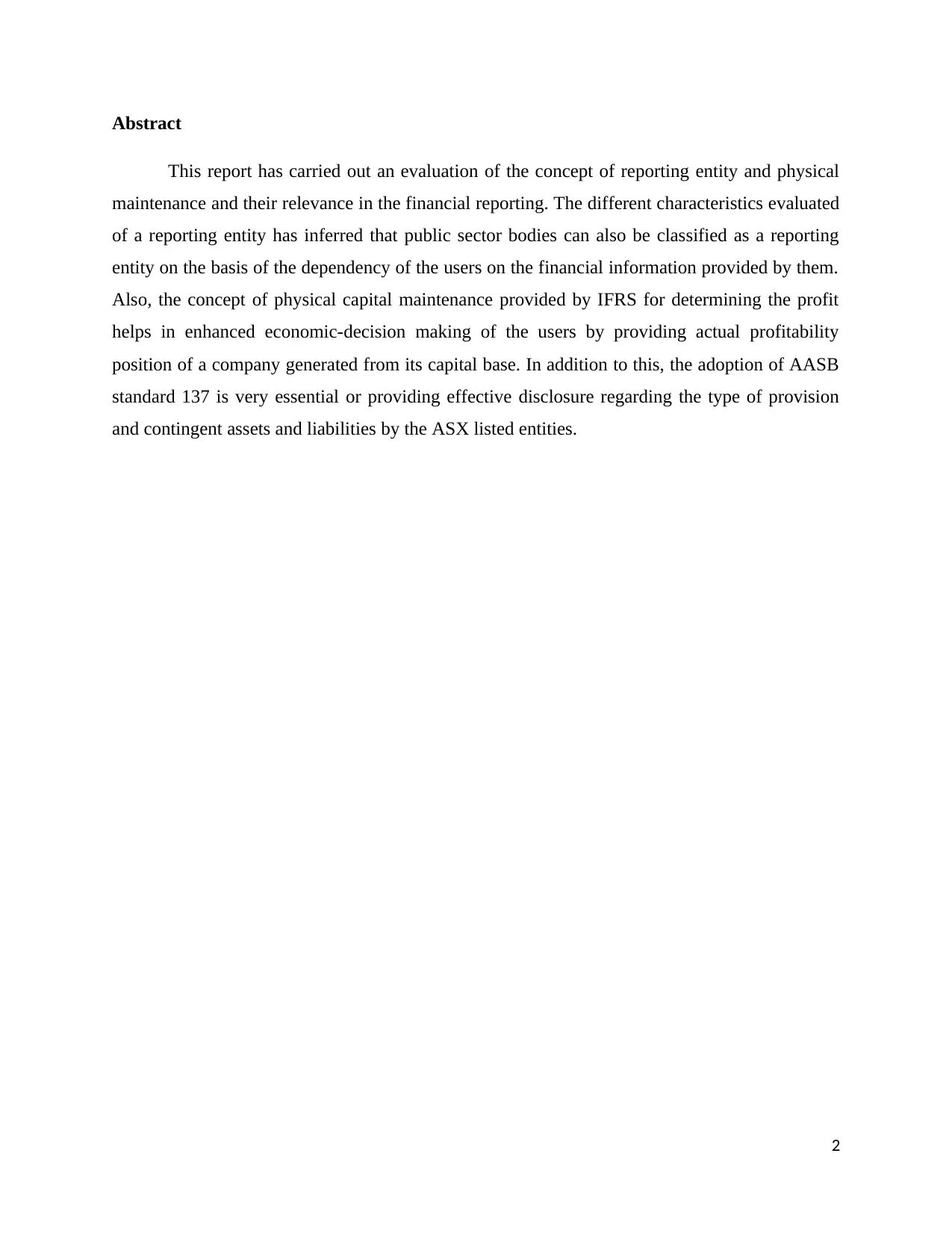
Abstract
This report has carried out an evaluation of the concept of reporting entity and physical
maintenance and their relevance in the financial reporting. The different characteristics evaluated
of a reporting entity has inferred that public sector bodies can also be classified as a reporting
entity on the basis of the dependency of the users on the financial information provided by them.
Also, the concept of physical capital maintenance provided by IFRS for determining the profit
helps in enhanced economic-decision making of the users by providing actual profitability
position of a company generated from its capital base. In addition to this, the adoption of AASB
standard 137 is very essential or providing effective disclosure regarding the type of provision
and contingent assets and liabilities by the ASX listed entities.
2
This report has carried out an evaluation of the concept of reporting entity and physical
maintenance and their relevance in the financial reporting. The different characteristics evaluated
of a reporting entity has inferred that public sector bodies can also be classified as a reporting
entity on the basis of the dependency of the users on the financial information provided by them.
Also, the concept of physical capital maintenance provided by IFRS for determining the profit
helps in enhanced economic-decision making of the users by providing actual profitability
position of a company generated from its capital base. In addition to this, the adoption of AASB
standard 137 is very essential or providing effective disclosure regarding the type of provision
and contingent assets and liabilities by the ASX listed entities.
2
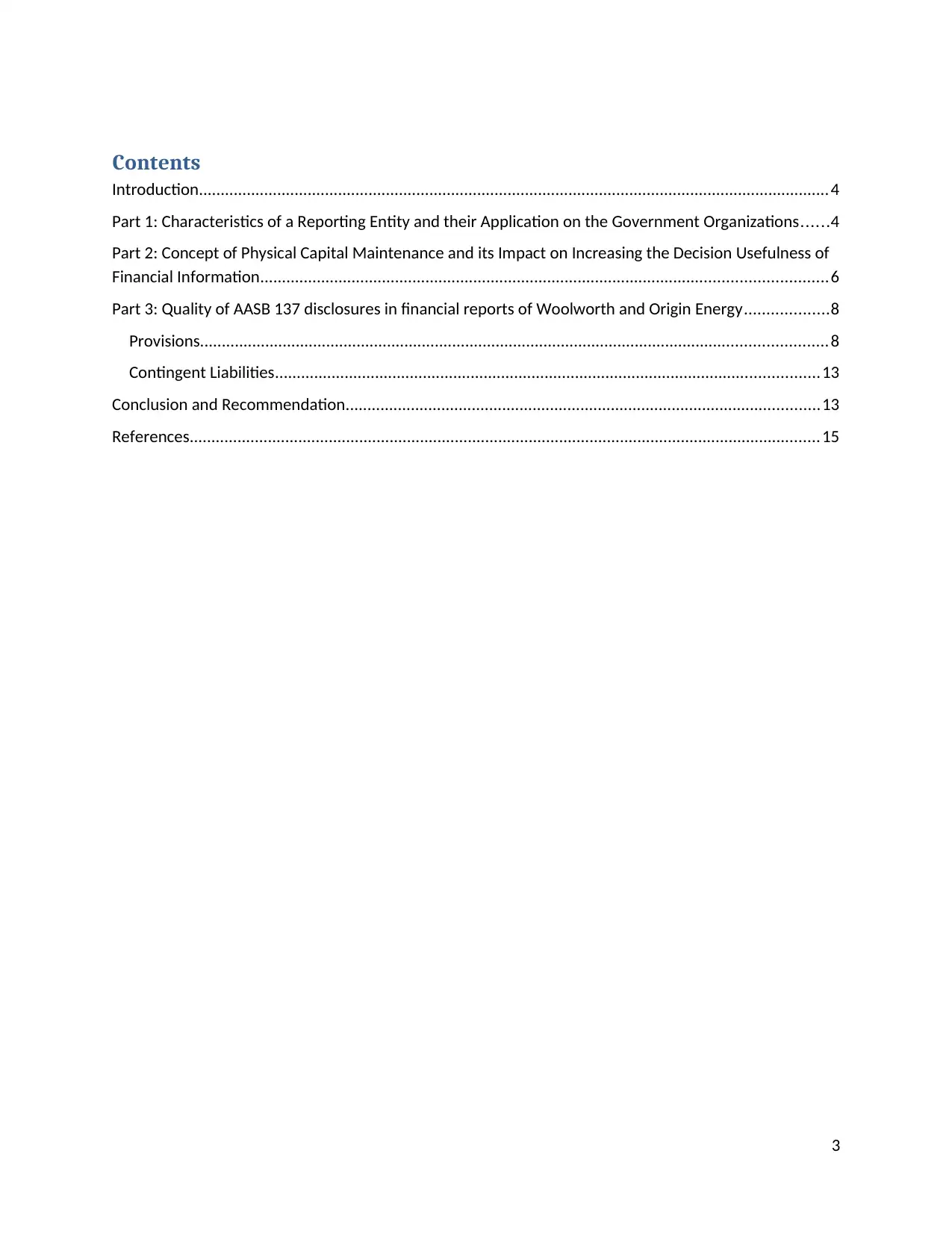
Contents
Introduction.................................................................................................................................................4
Part 1: Characteristics of a Reporting Entity and their Application on the Government Organizations......4
Part 2: Concept of Physical Capital Maintenance and its Impact on Increasing the Decision Usefulness of
Financial Information..................................................................................................................................6
Part 3: Quality of AASB 137 disclosures in financial reports of Woolworth and Origin Energy...................8
Provisions................................................................................................................................................8
Contingent Liabilities.............................................................................................................................13
Conclusion and Recommendation.............................................................................................................13
References.................................................................................................................................................15
3
Introduction.................................................................................................................................................4
Part 1: Characteristics of a Reporting Entity and their Application on the Government Organizations......4
Part 2: Concept of Physical Capital Maintenance and its Impact on Increasing the Decision Usefulness of
Financial Information..................................................................................................................................6
Part 3: Quality of AASB 137 disclosures in financial reports of Woolworth and Origin Energy...................8
Provisions................................................................................................................................................8
Contingent Liabilities.............................................................................................................................13
Conclusion and Recommendation.............................................................................................................13
References.................................................................................................................................................15
3
⊘ This is a preview!⊘
Do you want full access?
Subscribe today to unlock all pages.

Trusted by 1+ million students worldwide
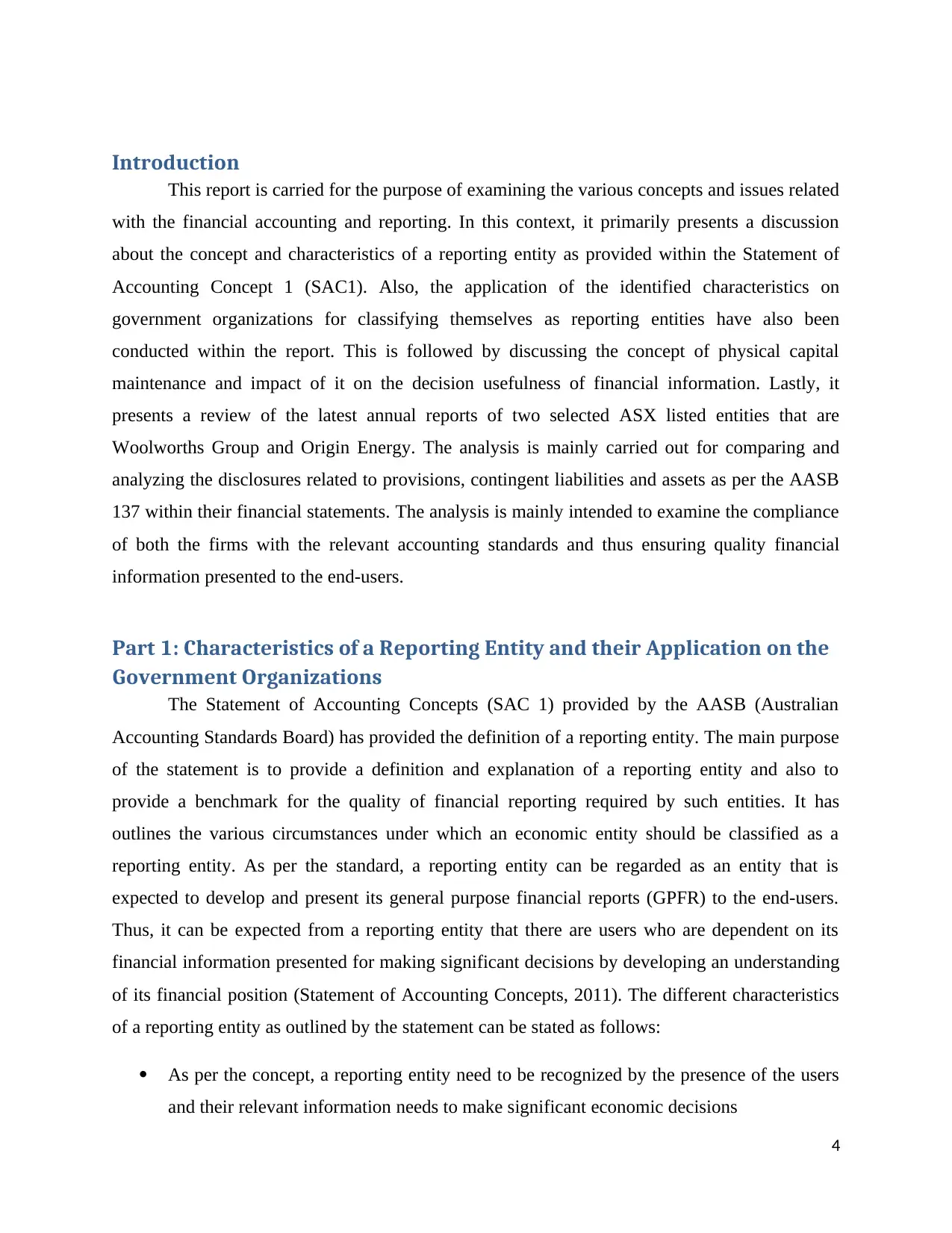
Introduction
This report is carried for the purpose of examining the various concepts and issues related
with the financial accounting and reporting. In this context, it primarily presents a discussion
about the concept and characteristics of a reporting entity as provided within the Statement of
Accounting Concept 1 (SAC1). Also, the application of the identified characteristics on
government organizations for classifying themselves as reporting entities have also been
conducted within the report. This is followed by discussing the concept of physical capital
maintenance and impact of it on the decision usefulness of financial information. Lastly, it
presents a review of the latest annual reports of two selected ASX listed entities that are
Woolworths Group and Origin Energy. The analysis is mainly carried out for comparing and
analyzing the disclosures related to provisions, contingent liabilities and assets as per the AASB
137 within their financial statements. The analysis is mainly intended to examine the compliance
of both the firms with the relevant accounting standards and thus ensuring quality financial
information presented to the end-users.
Part 1: Characteristics of a Reporting Entity and their Application on the
Government Organizations
The Statement of Accounting Concepts (SAC 1) provided by the AASB (Australian
Accounting Standards Board) has provided the definition of a reporting entity. The main purpose
of the statement is to provide a definition and explanation of a reporting entity and also to
provide a benchmark for the quality of financial reporting required by such entities. It has
outlines the various circumstances under which an economic entity should be classified as a
reporting entity. As per the standard, a reporting entity can be regarded as an entity that is
expected to develop and present its general purpose financial reports (GPFR) to the end-users.
Thus, it can be expected from a reporting entity that there are users who are dependent on its
financial information presented for making significant decisions by developing an understanding
of its financial position (Statement of Accounting Concepts, 2011). The different characteristics
of a reporting entity as outlined by the statement can be stated as follows:
As per the concept, a reporting entity need to be recognized by the presence of the users
and their relevant information needs to make significant economic decisions
4
This report is carried for the purpose of examining the various concepts and issues related
with the financial accounting and reporting. In this context, it primarily presents a discussion
about the concept and characteristics of a reporting entity as provided within the Statement of
Accounting Concept 1 (SAC1). Also, the application of the identified characteristics on
government organizations for classifying themselves as reporting entities have also been
conducted within the report. This is followed by discussing the concept of physical capital
maintenance and impact of it on the decision usefulness of financial information. Lastly, it
presents a review of the latest annual reports of two selected ASX listed entities that are
Woolworths Group and Origin Energy. The analysis is mainly carried out for comparing and
analyzing the disclosures related to provisions, contingent liabilities and assets as per the AASB
137 within their financial statements. The analysis is mainly intended to examine the compliance
of both the firms with the relevant accounting standards and thus ensuring quality financial
information presented to the end-users.
Part 1: Characteristics of a Reporting Entity and their Application on the
Government Organizations
The Statement of Accounting Concepts (SAC 1) provided by the AASB (Australian
Accounting Standards Board) has provided the definition of a reporting entity. The main purpose
of the statement is to provide a definition and explanation of a reporting entity and also to
provide a benchmark for the quality of financial reporting required by such entities. It has
outlines the various circumstances under which an economic entity should be classified as a
reporting entity. As per the standard, a reporting entity can be regarded as an entity that is
expected to develop and present its general purpose financial reports (GPFR) to the end-users.
Thus, it can be expected from a reporting entity that there are users who are dependent on its
financial information presented for making significant decisions by developing an understanding
of its financial position (Statement of Accounting Concepts, 2011). The different characteristics
of a reporting entity as outlined by the statement can be stated as follows:
As per the concept, a reporting entity need to be recognized by the presence of the users
and their relevant information needs to make significant economic decisions
4
Paraphrase This Document
Need a fresh take? Get an instant paraphrase of this document with our AI Paraphraser

The concept of reporting entity as provided by the statement is not dependent on the fact
that whether an entity belongs to public or private sector. Also, it is not dependent on the
purpose for which it was established such as profit or non-profit and the manner of its
constitution such as legal or other (Reilly, 2015).
There exists a relation between the concept of entity classified as reporting and its
associated boundaries. For example, if an entity is recognized as reporting on the basis of
its legal aspect then its boundaries is defined in respect to its legal considerations. On the
other hand, if an entity is regarded to be reporting on the basis of fund concept then it
would imply that that its significant boundaries are classified on the basis of functional
uses.
The information needs of different end-users are met by the resources disclosures
provided by an entity that it deploys and this provides them assistance to gain an estimate
of its present and future financial performance (Statement of Accounting Concepts,
2011).
In some circumstances, a reporting entity can be classified on an individual basis while in
others it can be regarded as a significant group of entities
The existence of dependent users is associated with the extent of separation between the
management and the owners and others having an economic interest within an entity. The
greater is the spread between the management and the others members associated with an
organization the larger exists the possibility of presence of dependent users
Also, larger is the economic or political influence of an entity the greater is its significant
impact on the welfare of the external parties. This leads to more increase in the possibility
of presence of dependent users of such an entity for making significant decisions on
resource allocation and distribution.
In addition to this, as per SAC 1 the size of an entity is also significantly related with the
presence of its dependent users. The greater is the size of an entity the larger is the
significant amount of resources allocated and thus there exists large possibility of the
presence of its dependent users (Australian Accounting Standards Board, 2018).
On the basis of analysis of the characteristics of reporting entity, it has been illustrated that a
reporting entity classification is not dependent whether it is a public or private sector entity.
Saccon (2011) has also stated that its classification is mainly dependent on the presence of
5
that whether an entity belongs to public or private sector. Also, it is not dependent on the
purpose for which it was established such as profit or non-profit and the manner of its
constitution such as legal or other (Reilly, 2015).
There exists a relation between the concept of entity classified as reporting and its
associated boundaries. For example, if an entity is recognized as reporting on the basis of
its legal aspect then its boundaries is defined in respect to its legal considerations. On the
other hand, if an entity is regarded to be reporting on the basis of fund concept then it
would imply that that its significant boundaries are classified on the basis of functional
uses.
The information needs of different end-users are met by the resources disclosures
provided by an entity that it deploys and this provides them assistance to gain an estimate
of its present and future financial performance (Statement of Accounting Concepts,
2011).
In some circumstances, a reporting entity can be classified on an individual basis while in
others it can be regarded as a significant group of entities
The existence of dependent users is associated with the extent of separation between the
management and the owners and others having an economic interest within an entity. The
greater is the spread between the management and the others members associated with an
organization the larger exists the possibility of presence of dependent users
Also, larger is the economic or political influence of an entity the greater is its significant
impact on the welfare of the external parties. This leads to more increase in the possibility
of presence of dependent users of such an entity for making significant decisions on
resource allocation and distribution.
In addition to this, as per SAC 1 the size of an entity is also significantly related with the
presence of its dependent users. The greater is the size of an entity the larger is the
significant amount of resources allocated and thus there exists large possibility of the
presence of its dependent users (Australian Accounting Standards Board, 2018).
On the basis of analysis of the characteristics of reporting entity, it has been illustrated that a
reporting entity classification is not dependent whether it is a public or private sector entity.
Saccon (2011) has also stated that its classification is mainly dependent on the presence of
5
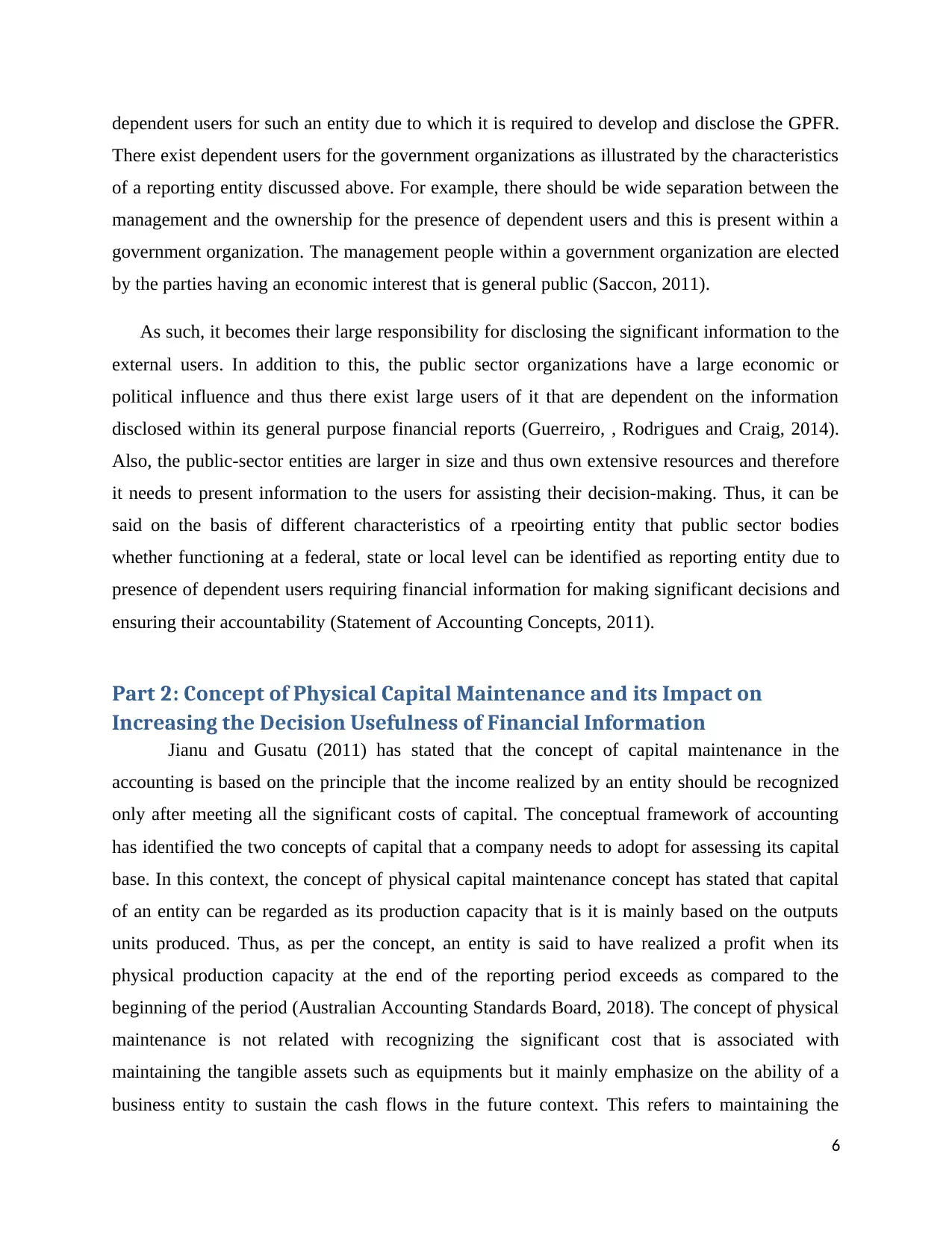
dependent users for such an entity due to which it is required to develop and disclose the GPFR.
There exist dependent users for the government organizations as illustrated by the characteristics
of a reporting entity discussed above. For example, there should be wide separation between the
management and the ownership for the presence of dependent users and this is present within a
government organization. The management people within a government organization are elected
by the parties having an economic interest that is general public (Saccon, 2011).
As such, it becomes their large responsibility for disclosing the significant information to the
external users. In addition to this, the public sector organizations have a large economic or
political influence and thus there exist large users of it that are dependent on the information
disclosed within its general purpose financial reports (Guerreiro, , Rodrigues and Craig, 2014).
Also, the public-sector entities are larger in size and thus own extensive resources and therefore
it needs to present information to the users for assisting their decision-making. Thus, it can be
said on the basis of different characteristics of a rpeoirting entity that public sector bodies
whether functioning at a federal, state or local level can be identified as reporting entity due to
presence of dependent users requiring financial information for making significant decisions and
ensuring their accountability (Statement of Accounting Concepts, 2011).
Part 2: Concept of Physical Capital Maintenance and its Impact on
Increasing the Decision Usefulness of Financial Information
Jianu and Gusatu (2011) has stated that the concept of capital maintenance in the
accounting is based on the principle that the income realized by an entity should be recognized
only after meeting all the significant costs of capital. The conceptual framework of accounting
has identified the two concepts of capital that a company needs to adopt for assessing its capital
base. In this context, the concept of physical capital maintenance concept has stated that capital
of an entity can be regarded as its production capacity that is it is mainly based on the outputs
units produced. Thus, as per the concept, an entity is said to have realized a profit when its
physical production capacity at the end of the reporting period exceeds as compared to the
beginning of the period (Australian Accounting Standards Board, 2018). The concept of physical
maintenance is not related with recognizing the significant cost that is associated with
maintaining the tangible assets such as equipments but it mainly emphasize on the ability of a
business entity to sustain the cash flows in the future context. This refers to maintaining the
6
There exist dependent users for the government organizations as illustrated by the characteristics
of a reporting entity discussed above. For example, there should be wide separation between the
management and the ownership for the presence of dependent users and this is present within a
government organization. The management people within a government organization are elected
by the parties having an economic interest that is general public (Saccon, 2011).
As such, it becomes their large responsibility for disclosing the significant information to the
external users. In addition to this, the public sector organizations have a large economic or
political influence and thus there exist large users of it that are dependent on the information
disclosed within its general purpose financial reports (Guerreiro, , Rodrigues and Craig, 2014).
Also, the public-sector entities are larger in size and thus own extensive resources and therefore
it needs to present information to the users for assisting their decision-making. Thus, it can be
said on the basis of different characteristics of a rpeoirting entity that public sector bodies
whether functioning at a federal, state or local level can be identified as reporting entity due to
presence of dependent users requiring financial information for making significant decisions and
ensuring their accountability (Statement of Accounting Concepts, 2011).
Part 2: Concept of Physical Capital Maintenance and its Impact on
Increasing the Decision Usefulness of Financial Information
Jianu and Gusatu (2011) has stated that the concept of capital maintenance in the
accounting is based on the principle that the income realized by an entity should be recognized
only after meeting all the significant costs of capital. The conceptual framework of accounting
has identified the two concepts of capital that a company needs to adopt for assessing its capital
base. In this context, the concept of physical capital maintenance concept has stated that capital
of an entity can be regarded as its production capacity that is it is mainly based on the outputs
units produced. Thus, as per the concept, an entity is said to have realized a profit when its
physical production capacity at the end of the reporting period exceeds as compared to the
beginning of the period (Australian Accounting Standards Board, 2018). The concept of physical
maintenance is not related with recognizing the significant cost that is associated with
maintaining the tangible assets such as equipments but it mainly emphasize on the ability of a
business entity to sustain the cash flows in the future context. This refers to maintaining the
6
⊘ This is a preview!⊘
Do you want full access?
Subscribe today to unlock all pages.

Trusted by 1+ million students worldwide
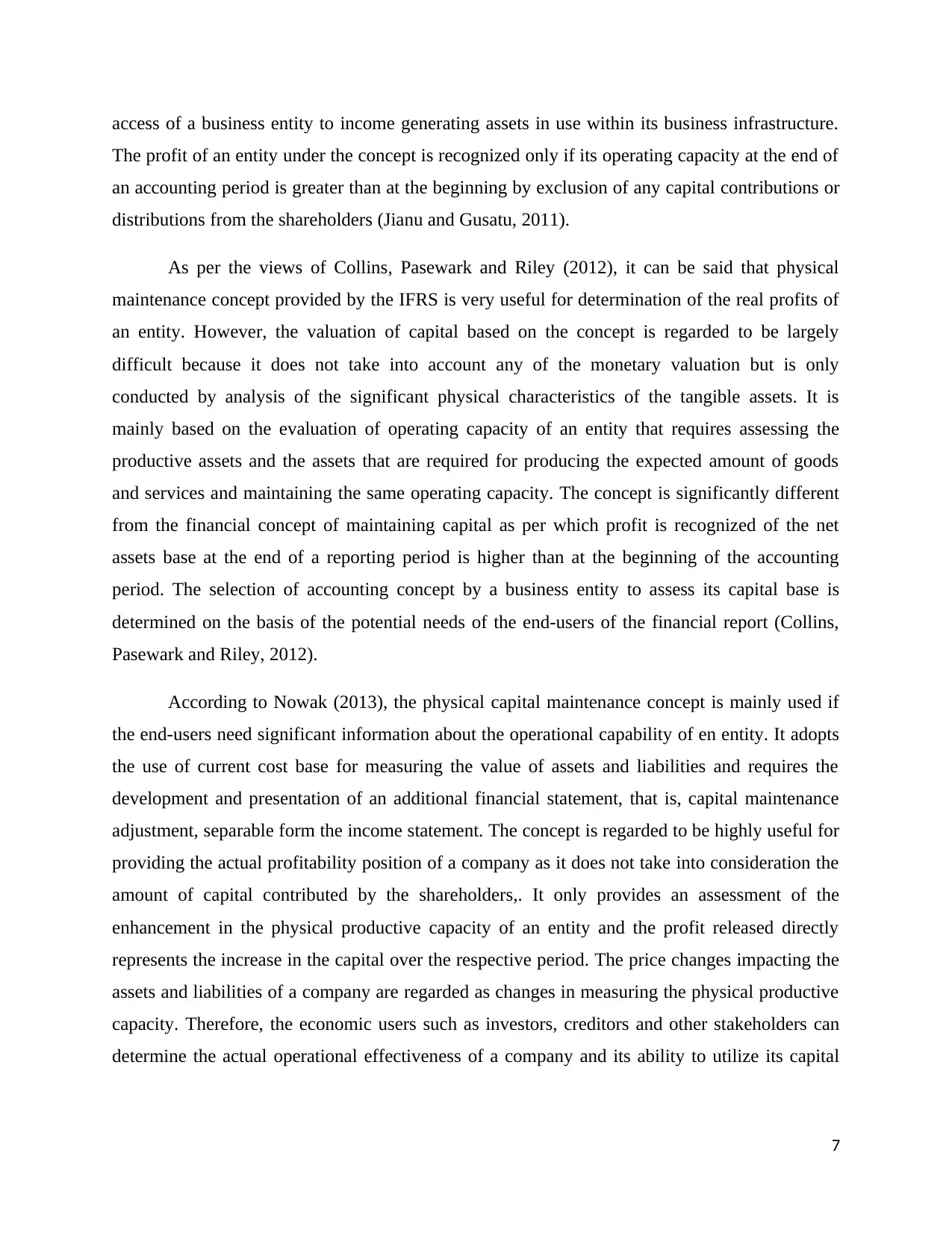
access of a business entity to income generating assets in use within its business infrastructure.
The profit of an entity under the concept is recognized only if its operating capacity at the end of
an accounting period is greater than at the beginning by exclusion of any capital contributions or
distributions from the shareholders (Jianu and Gusatu, 2011).
As per the views of Collins, Pasewark and Riley (2012), it can be said that physical
maintenance concept provided by the IFRS is very useful for determination of the real profits of
an entity. However, the valuation of capital based on the concept is regarded to be largely
difficult because it does not take into account any of the monetary valuation but is only
conducted by analysis of the significant physical characteristics of the tangible assets. It is
mainly based on the evaluation of operating capacity of an entity that requires assessing the
productive assets and the assets that are required for producing the expected amount of goods
and services and maintaining the same operating capacity. The concept is significantly different
from the financial concept of maintaining capital as per which profit is recognized of the net
assets base at the end of a reporting period is higher than at the beginning of the accounting
period. The selection of accounting concept by a business entity to assess its capital base is
determined on the basis of the potential needs of the end-users of the financial report (Collins,
Pasewark and Riley, 2012).
According to Nowak (2013), the physical capital maintenance concept is mainly used if
the end-users need significant information about the operational capability of en entity. It adopts
the use of current cost base for measuring the value of assets and liabilities and requires the
development and presentation of an additional financial statement, that is, capital maintenance
adjustment, separable form the income statement. The concept is regarded to be highly useful for
providing the actual profitability position of a company as it does not take into consideration the
amount of capital contributed by the shareholders,. It only provides an assessment of the
enhancement in the physical productive capacity of an entity and the profit released directly
represents the increase in the capital over the respective period. The price changes impacting the
assets and liabilities of a company are regarded as changes in measuring the physical productive
capacity. Therefore, the economic users such as investors, creditors and other stakeholders can
determine the actual operational effectiveness of a company and its ability to utilize its capital
7
The profit of an entity under the concept is recognized only if its operating capacity at the end of
an accounting period is greater than at the beginning by exclusion of any capital contributions or
distributions from the shareholders (Jianu and Gusatu, 2011).
As per the views of Collins, Pasewark and Riley (2012), it can be said that physical
maintenance concept provided by the IFRS is very useful for determination of the real profits of
an entity. However, the valuation of capital based on the concept is regarded to be largely
difficult because it does not take into account any of the monetary valuation but is only
conducted by analysis of the significant physical characteristics of the tangible assets. It is
mainly based on the evaluation of operating capacity of an entity that requires assessing the
productive assets and the assets that are required for producing the expected amount of goods
and services and maintaining the same operating capacity. The concept is significantly different
from the financial concept of maintaining capital as per which profit is recognized of the net
assets base at the end of a reporting period is higher than at the beginning of the accounting
period. The selection of accounting concept by a business entity to assess its capital base is
determined on the basis of the potential needs of the end-users of the financial report (Collins,
Pasewark and Riley, 2012).
According to Nowak (2013), the physical capital maintenance concept is mainly used if
the end-users need significant information about the operational capability of en entity. It adopts
the use of current cost base for measuring the value of assets and liabilities and requires the
development and presentation of an additional financial statement, that is, capital maintenance
adjustment, separable form the income statement. The concept is regarded to be highly useful for
providing the actual profitability position of a company as it does not take into consideration the
amount of capital contributed by the shareholders,. It only provides an assessment of the
enhancement in the physical productive capacity of an entity and the profit released directly
represents the increase in the capital over the respective period. The price changes impacting the
assets and liabilities of a company are regarded as changes in measuring the physical productive
capacity. Therefore, the economic users such as investors, creditors and other stakeholders can
determine the actual operational effectiveness of a company and its ability to utilize its capital
7
Paraphrase This Document
Need a fresh take? Get an instant paraphrase of this document with our AI Paraphraser
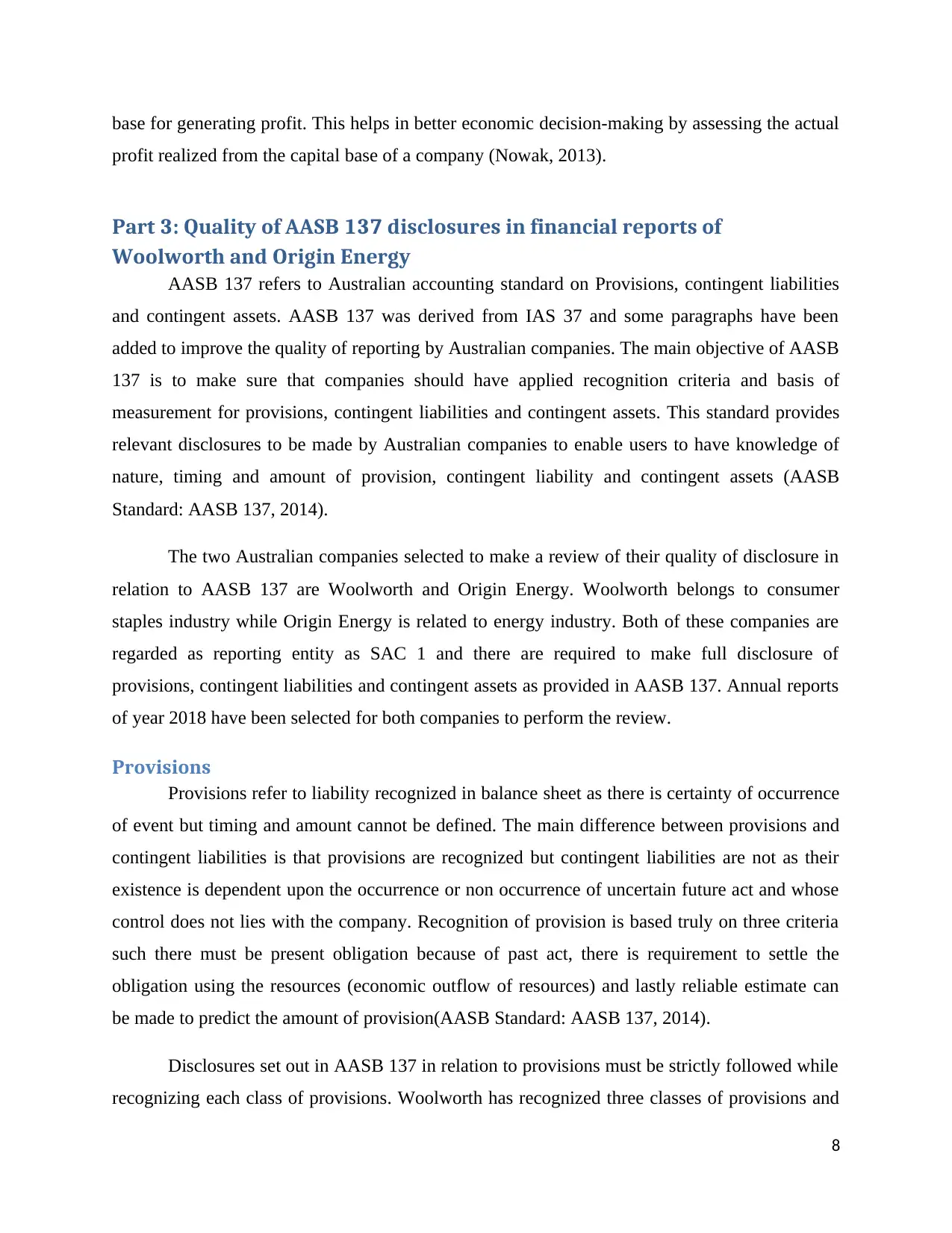
base for generating profit. This helps in better economic decision-making by assessing the actual
profit realized from the capital base of a company (Nowak, 2013).
Part 3: Quality of AASB 137 disclosures in financial reports of
Woolworth and Origin Energy
AASB 137 refers to Australian accounting standard on Provisions, contingent liabilities
and contingent assets. AASB 137 was derived from IAS 37 and some paragraphs have been
added to improve the quality of reporting by Australian companies. The main objective of AASB
137 is to make sure that companies should have applied recognition criteria and basis of
measurement for provisions, contingent liabilities and contingent assets. This standard provides
relevant disclosures to be made by Australian companies to enable users to have knowledge of
nature, timing and amount of provision, contingent liability and contingent assets (AASB
Standard: AASB 137, 2014).
The two Australian companies selected to make a review of their quality of disclosure in
relation to AASB 137 are Woolworth and Origin Energy. Woolworth belongs to consumer
staples industry while Origin Energy is related to energy industry. Both of these companies are
regarded as reporting entity as SAC 1 and there are required to make full disclosure of
provisions, contingent liabilities and contingent assets as provided in AASB 137. Annual reports
of year 2018 have been selected for both companies to perform the review.
Provisions
Provisions refer to liability recognized in balance sheet as there is certainty of occurrence
of event but timing and amount cannot be defined. The main difference between provisions and
contingent liabilities is that provisions are recognized but contingent liabilities are not as their
existence is dependent upon the occurrence or non occurrence of uncertain future act and whose
control does not lies with the company. Recognition of provision is based truly on three criteria
such there must be present obligation because of past act, there is requirement to settle the
obligation using the resources (economic outflow of resources) and lastly reliable estimate can
be made to predict the amount of provision(AASB Standard: AASB 137, 2014).
Disclosures set out in AASB 137 in relation to provisions must be strictly followed while
recognizing each class of provisions. Woolworth has recognized three classes of provisions and
8
profit realized from the capital base of a company (Nowak, 2013).
Part 3: Quality of AASB 137 disclosures in financial reports of
Woolworth and Origin Energy
AASB 137 refers to Australian accounting standard on Provisions, contingent liabilities
and contingent assets. AASB 137 was derived from IAS 37 and some paragraphs have been
added to improve the quality of reporting by Australian companies. The main objective of AASB
137 is to make sure that companies should have applied recognition criteria and basis of
measurement for provisions, contingent liabilities and contingent assets. This standard provides
relevant disclosures to be made by Australian companies to enable users to have knowledge of
nature, timing and amount of provision, contingent liability and contingent assets (AASB
Standard: AASB 137, 2014).
The two Australian companies selected to make a review of their quality of disclosure in
relation to AASB 137 are Woolworth and Origin Energy. Woolworth belongs to consumer
staples industry while Origin Energy is related to energy industry. Both of these companies are
regarded as reporting entity as SAC 1 and there are required to make full disclosure of
provisions, contingent liabilities and contingent assets as provided in AASB 137. Annual reports
of year 2018 have been selected for both companies to perform the review.
Provisions
Provisions refer to liability recognized in balance sheet as there is certainty of occurrence
of event but timing and amount cannot be defined. The main difference between provisions and
contingent liabilities is that provisions are recognized but contingent liabilities are not as their
existence is dependent upon the occurrence or non occurrence of uncertain future act and whose
control does not lies with the company. Recognition of provision is based truly on three criteria
such there must be present obligation because of past act, there is requirement to settle the
obligation using the resources (economic outflow of resources) and lastly reliable estimate can
be made to predict the amount of provision(AASB Standard: AASB 137, 2014).
Disclosures set out in AASB 137 in relation to provisions must be strictly followed while
recognizing each class of provisions. Woolworth has recognized three classes of provisions and
8

they are employee benefits, self-insured risks and restructuring, onerous contracts, store exit cost
and other (Woolworth Group: Annual report, 2018).
(Image 1, Woolworth disclosure on provisions, Source: Annual report, 2018) Link:
https://www.woolworthsgroup.com.au/icms_docs/195396_annual-report-2018.pdf
On the other hand, Origin Energy has recognized two classes of provisions and they are
restoration cost and other provisions.
(Image 2, Origin Energy disclosure on movement in provisions, Source: Annual report, 2018)
Link: https://www.originenergy.com.au/content/dam/origin/about/investors-media/documents/
Origin_2018_Annual_Report.pdf
It has been found that Woolworth has disclosed two sets of tables for provisions, one for
balance at the end of year 2017 and 2018 and other table to show the movement in balances of
provisions(Woolworth Group: Annual report, 2018). While, Origin Energy has disclosed one set
9
and other (Woolworth Group: Annual report, 2018).
(Image 1, Woolworth disclosure on provisions, Source: Annual report, 2018) Link:
https://www.woolworthsgroup.com.au/icms_docs/195396_annual-report-2018.pdf
On the other hand, Origin Energy has recognized two classes of provisions and they are
restoration cost and other provisions.
(Image 2, Origin Energy disclosure on movement in provisions, Source: Annual report, 2018)
Link: https://www.originenergy.com.au/content/dam/origin/about/investors-media/documents/
Origin_2018_Annual_Report.pdf
It has been found that Woolworth has disclosed two sets of tables for provisions, one for
balance at the end of year 2017 and 2018 and other table to show the movement in balances of
provisions(Woolworth Group: Annual report, 2018). While, Origin Energy has disclosed one set
9
⊘ This is a preview!⊘
Do you want full access?
Subscribe today to unlock all pages.

Trusted by 1+ million students worldwide
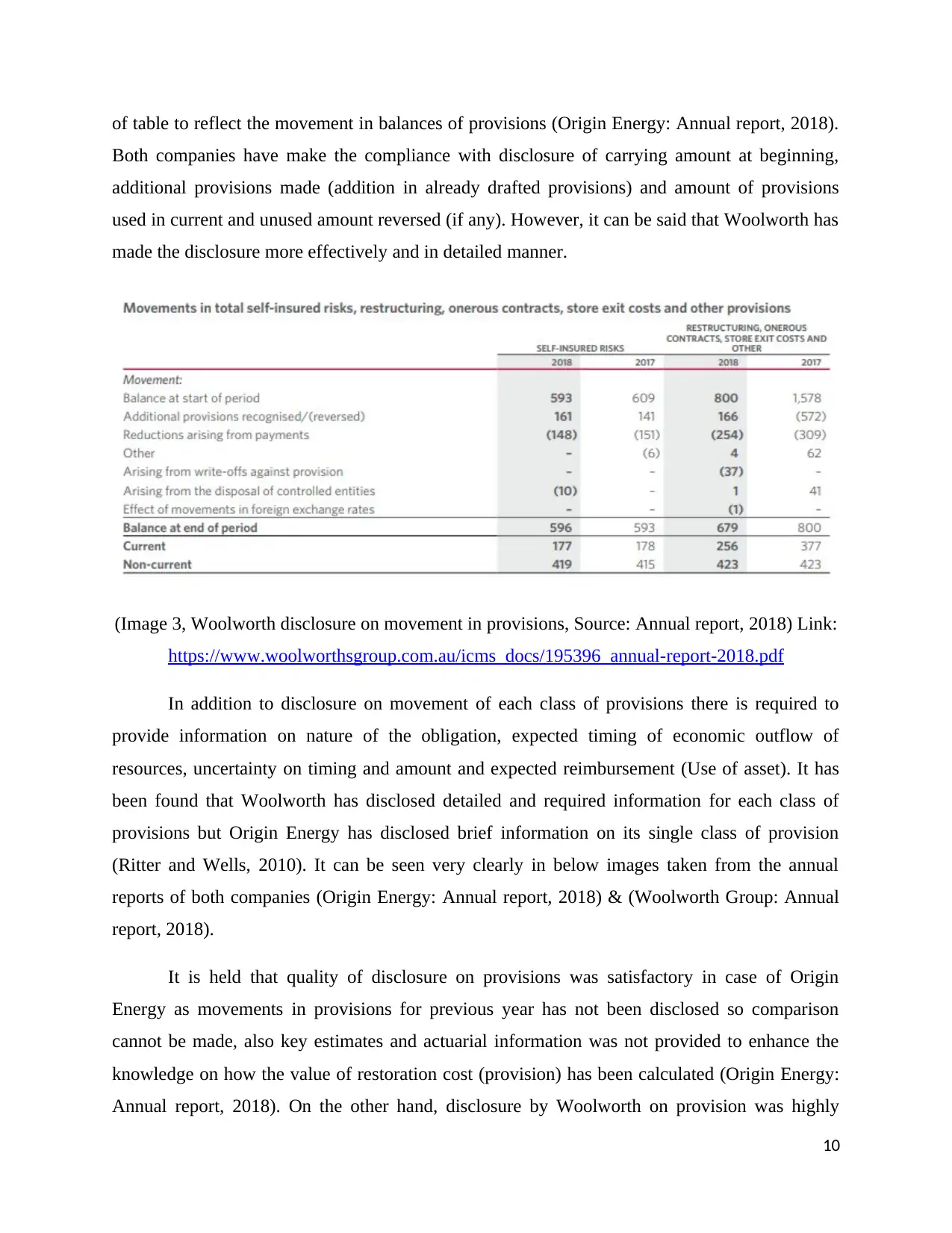
of table to reflect the movement in balances of provisions (Origin Energy: Annual report, 2018).
Both companies have make the compliance with disclosure of carrying amount at beginning,
additional provisions made (addition in already drafted provisions) and amount of provisions
used in current and unused amount reversed (if any). However, it can be said that Woolworth has
made the disclosure more effectively and in detailed manner.
(Image 3, Woolworth disclosure on movement in provisions, Source: Annual report, 2018) Link:
https://www.woolworthsgroup.com.au/icms_docs/195396_annual-report-2018.pdf
In addition to disclosure on movement of each class of provisions there is required to
provide information on nature of the obligation, expected timing of economic outflow of
resources, uncertainty on timing and amount and expected reimbursement (Use of asset). It has
been found that Woolworth has disclosed detailed and required information for each class of
provisions but Origin Energy has disclosed brief information on its single class of provision
(Ritter and Wells, 2010). It can be seen very clearly in below images taken from the annual
reports of both companies (Origin Energy: Annual report, 2018) & (Woolworth Group: Annual
report, 2018).
It is held that quality of disclosure on provisions was satisfactory in case of Origin
Energy as movements in provisions for previous year has not been disclosed so comparison
cannot be made, also key estimates and actuarial information was not provided to enhance the
knowledge on how the value of restoration cost (provision) has been calculated (Origin Energy:
Annual report, 2018). On the other hand, disclosure by Woolworth on provision was highly
10
Both companies have make the compliance with disclosure of carrying amount at beginning,
additional provisions made (addition in already drafted provisions) and amount of provisions
used in current and unused amount reversed (if any). However, it can be said that Woolworth has
made the disclosure more effectively and in detailed manner.
(Image 3, Woolworth disclosure on movement in provisions, Source: Annual report, 2018) Link:
https://www.woolworthsgroup.com.au/icms_docs/195396_annual-report-2018.pdf
In addition to disclosure on movement of each class of provisions there is required to
provide information on nature of the obligation, expected timing of economic outflow of
resources, uncertainty on timing and amount and expected reimbursement (Use of asset). It has
been found that Woolworth has disclosed detailed and required information for each class of
provisions but Origin Energy has disclosed brief information on its single class of provision
(Ritter and Wells, 2010). It can be seen very clearly in below images taken from the annual
reports of both companies (Origin Energy: Annual report, 2018) & (Woolworth Group: Annual
report, 2018).
It is held that quality of disclosure on provisions was satisfactory in case of Origin
Energy as movements in provisions for previous year has not been disclosed so comparison
cannot be made, also key estimates and actuarial information was not provided to enhance the
knowledge on how the value of restoration cost (provision) has been calculated (Origin Energy:
Annual report, 2018). On the other hand, disclosure by Woolworth on provision was highly
10
Paraphrase This Document
Need a fresh take? Get an instant paraphrase of this document with our AI Paraphraser
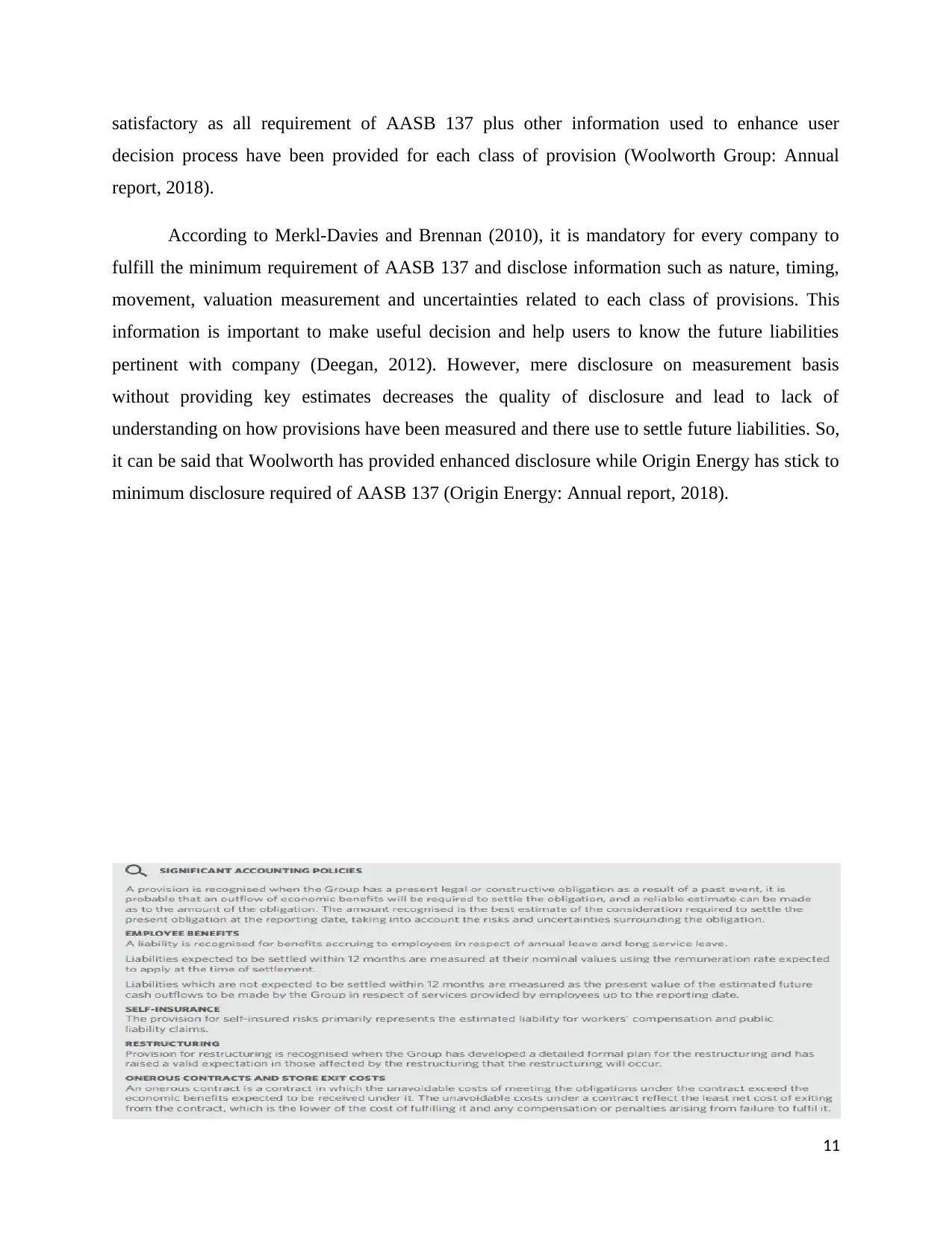
satisfactory as all requirement of AASB 137 plus other information used to enhance user
decision process have been provided for each class of provision (Woolworth Group: Annual
report, 2018).
According to Merkl-Davies and Brennan (2010), it is mandatory for every company to
fulfill the minimum requirement of AASB 137 and disclose information such as nature, timing,
movement, valuation measurement and uncertainties related to each class of provisions. This
information is important to make useful decision and help users to know the future liabilities
pertinent with company (Deegan, 2012). However, mere disclosure on measurement basis
without providing key estimates decreases the quality of disclosure and lead to lack of
understanding on how provisions have been measured and there use to settle future liabilities. So,
it can be said that Woolworth has provided enhanced disclosure while Origin Energy has stick to
minimum disclosure required of AASB 137 (Origin Energy: Annual report, 2018).
11
decision process have been provided for each class of provision (Woolworth Group: Annual
report, 2018).
According to Merkl-Davies and Brennan (2010), it is mandatory for every company to
fulfill the minimum requirement of AASB 137 and disclose information such as nature, timing,
movement, valuation measurement and uncertainties related to each class of provisions. This
information is important to make useful decision and help users to know the future liabilities
pertinent with company (Deegan, 2012). However, mere disclosure on measurement basis
without providing key estimates decreases the quality of disclosure and lead to lack of
understanding on how provisions have been measured and there use to settle future liabilities. So,
it can be said that Woolworth has provided enhanced disclosure while Origin Energy has stick to
minimum disclosure required of AASB 137 (Origin Energy: Annual report, 2018).
11
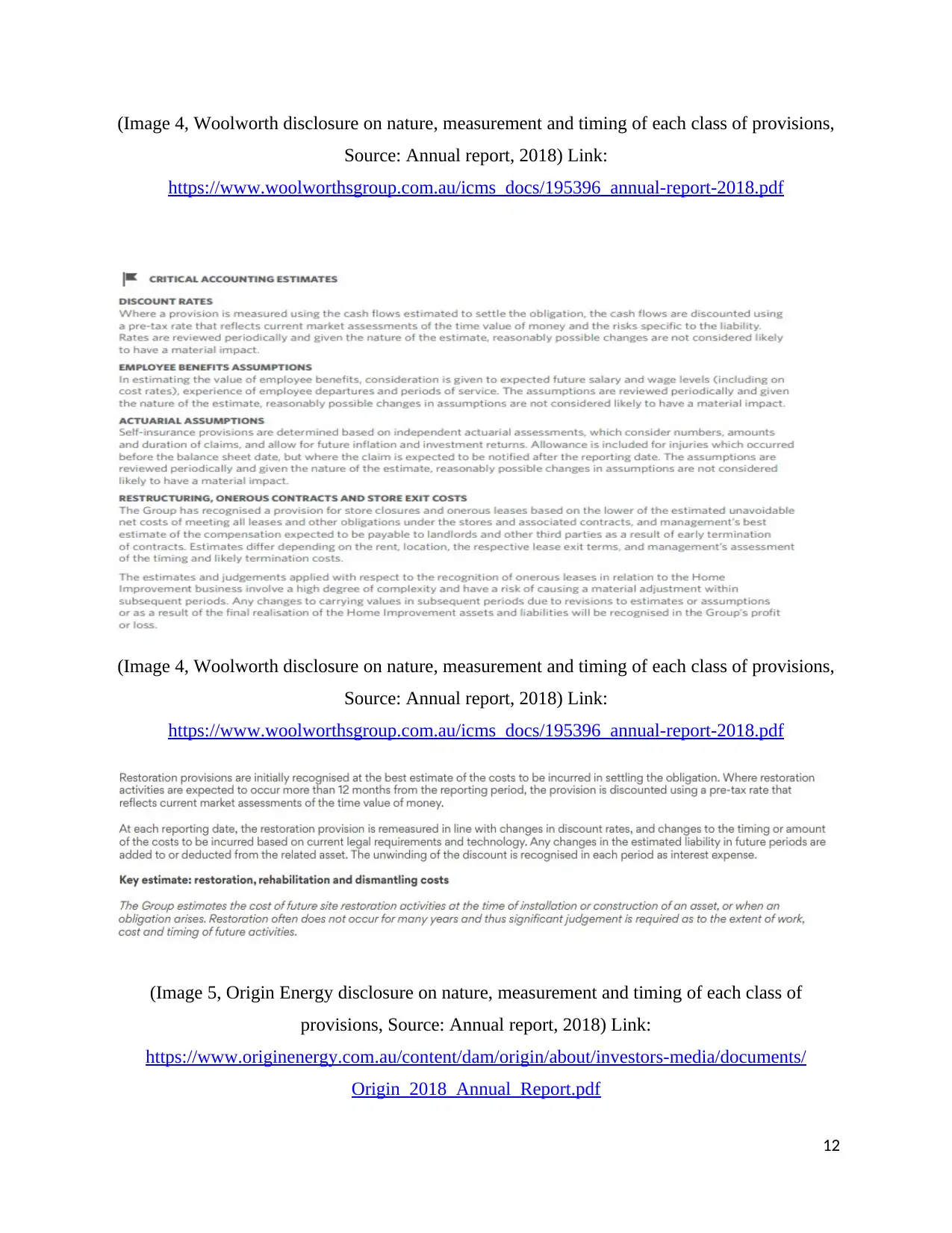
(Image 4, Woolworth disclosure on nature, measurement and timing of each class of provisions,
Source: Annual report, 2018) Link:
https://www.woolworthsgroup.com.au/icms_docs/195396_annual-report-2018.pdf
(Image 4, Woolworth disclosure on nature, measurement and timing of each class of provisions,
Source: Annual report, 2018) Link:
https://www.woolworthsgroup.com.au/icms_docs/195396_annual-report-2018.pdf
(Image 5, Origin Energy disclosure on nature, measurement and timing of each class of
provisions, Source: Annual report, 2018) Link:
https://www.originenergy.com.au/content/dam/origin/about/investors-media/documents/
Origin_2018_Annual_Report.pdf
12
Source: Annual report, 2018) Link:
https://www.woolworthsgroup.com.au/icms_docs/195396_annual-report-2018.pdf
(Image 4, Woolworth disclosure on nature, measurement and timing of each class of provisions,
Source: Annual report, 2018) Link:
https://www.woolworthsgroup.com.au/icms_docs/195396_annual-report-2018.pdf
(Image 5, Origin Energy disclosure on nature, measurement and timing of each class of
provisions, Source: Annual report, 2018) Link:
https://www.originenergy.com.au/content/dam/origin/about/investors-media/documents/
Origin_2018_Annual_Report.pdf
12
⊘ This is a preview!⊘
Do you want full access?
Subscribe today to unlock all pages.

Trusted by 1+ million students worldwide
1 out of 16
Related Documents
Your All-in-One AI-Powered Toolkit for Academic Success.
+13062052269
info@desklib.com
Available 24*7 on WhatsApp / Email
![[object Object]](/_next/static/media/star-bottom.7253800d.svg)
Unlock your academic potential
Copyright © 2020–2025 A2Z Services. All Rights Reserved. Developed and managed by ZUCOL.





